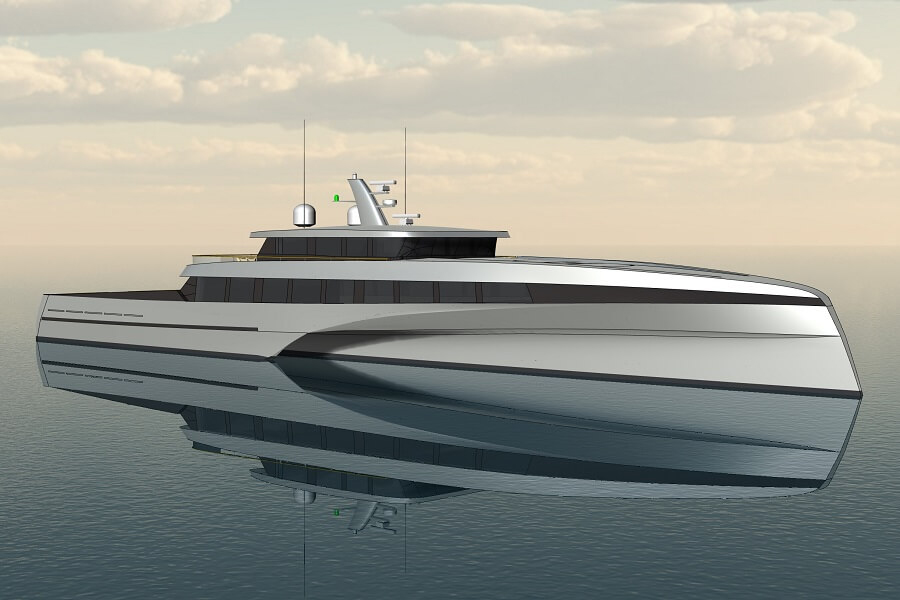 alt="Absolute signatures feature on 52 Fly"/>
alt="Absolute signatures feature on 52 Fly"/>
 alt="Bury Design releases 57m trimaran, 24m monohull concepts"/>
alt="Bury Design releases 57m trimaran, 24m monohull concepts"/>
Bury Design has released details of a 57.18m ‘stabilised monohull explorer’ built on an aluminium trimaran platform, with a beam of 12.84m and a shallow draft of just 2.4m at full load. Designed for global exploration, the superyacht has upper and lower lounges with expansive views, plus accommodation for 10 guests and nine crew. Forward is a touch-and-go landing pad with tender storage underneath.

The yacht has a touch-and-go helipad forward
A huge open aft deck measuring 16m x 12m (192sqm) offers configurable space for tenders, submarines and other toys to be stowed and launched. The deck is load rated with engineered hard patches to allow for specialised lifting equipment and containerised hardware, making the yacht suitable for research and exploration missions.
The yacht is built from marine-grade aluminium alloy and has a diesel-electric drive system, with four CAT diesel-driven generators powering twin 1100kw electric motors driving controllable pitch propellers. With a fuel capacity of 71,000 litres, the yacht has a range of 6,000nm at its cruising speed of 18 knots and a transatlantic range at its top speed of 22 knots, both with reserve.

The aft deck can be configured for owner requirements
The high speeds, efficiency and extensive range are due in large to the trimaran design, which features a long, narrow and deep centre hull containing the propulsive machinery. The outer hulls are engineered for minimal resistance and tailored to provide initial stability and a low rate of roll. The seakeeping and stability also benefit from Naiad Active Ride Control .
Paul Bury, founder and Director of Bury Design, said: “Designed to travel the world, whether for cruising, intrepid arctic exploration or open ocean transits, the stabilised monohull explorer provides exceptional levels of comfort, safety, and speed. The trimaran configuration is key to this.”

The Inception 24 has helm stations outside and inside
Bury has also shared designs for the Inception 24, a 23.98m monohull motor yacht with a sleek profile and hull design derived from ocean racing sailing yachts.
The yacht has a beam of 5.13m and can accommodate 12 guests during the day and four guests and two crew overnight. Suitable as a dayboat, overnighter or a megayacht tender, the lightweight build features a ‘future-proof’ diesel/battery/electric drive system and has the option of a high-speed foiling system.
“Conceived as a counterpoint to the modern planing dayboat, the Inception is about first principles and paring away the superfluous. The Inception 24 is the ultimate dayboat for a discerning boat owner,” said Bury, whose two-decade career includes working for Italian builder Wally, US-based Tripp Design and Australian studio Jutson Marine Design.

The 23.98m motor yacht has a hull like a sailing yacht
A lightweight, narrow hull is designed for high efficiency at moderate speeds. The use of a modern hull form derived from ocean racing yachts, coupled with lightweight construction and fitout, allows the vessel to far exceed theoretical hull speed.
The single, highly efficient, ducted propeller is powered by a diesel-electric hybrid system. A large battery bank, combined with the electric drive, provides silent motoring for over an hour at 15 knots and much longer at lower speeds. This configuration is future proofed by allowing technical innovations in power generation to be incorporated into the drive chain.

The diesel-electric hybrid can be complemented by a foiling system
The yacht has a top speed of 25 knots and a cruising speed of 15 knots, 2,000 litres of fuel and a range at cruising speed of 750nm with 10 per cent reserve. If more speed is desired, a fully foil borne, electric-drive solution will be available, offering speeds of over 40 knots.
The narrow hull form significantly lowers wave energy transferred to the vessel in the form of roll motions, which makes the onboard gyro stabiliser extremely effective at minimising roll. Further stability is achieved by the active water ballast system, which automatically and silently counters static heel due to passenger or wind loading.

The saloon is suitable for socialising or commuting
The main deck features an open aft area with outside helm, twin settees and a large sunbed with tender storage underneath.
The lower-deck layout includes a lounge midships with a C-shaped sofa to port and a row of chairs to starboard, so can be used for commuting or business meetings. A sunken galley is forward to starboard, an en-suite double cabin is to port and the master cabin with en-suite is in the bow.